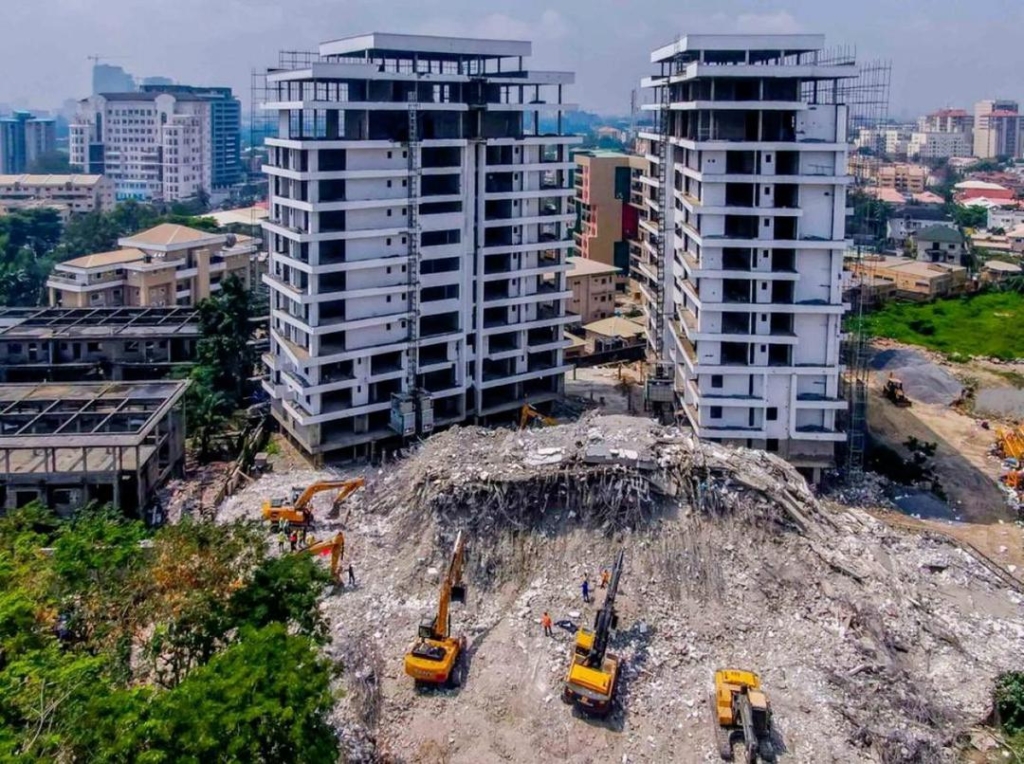
Before we dive into this, first we’ll like to extend our deepest condolences and sympathies to the families and loved ones of those who lost their lives in the tragic building collapse of a 21 storey building on Gerald road, Ikoyi that occurred on Monday 1st of November. The building was the third wing of a three-tower estate by estate developer, Femi Osibona. It would have been the first of its kind, including flats, duplexes, penthouses and an open recreation area with outdoor television, gym, swimming pool. The building still under construction crumbled on Monday afternoon trapping dozens of construction workers. According to Governor Jide Sanwoolu, the death toll has risen to 42 while the number of survivors has increased to 15. At this point is it difficult to ascertain just how many people were impacted by this tragedy but so far 49 families have filed missing person reports. The Governor also stated that funds had been set aside to help families with burial fees and to provide further medical support for the survivors.
Whilst the cause of the collapse is still uncertain, a building collapsing in one of Africa’s most populous cities is not completely out of the ordinary as they often tend to be the result of property and construction standards being routinely ignored. According to the Governor, the incident was a “terrible national disaster” and mistakes were made from all angles. An independent panel has been set up to uncover what it was that went wrong and what mistakes took place. In addition to this building collapsing. Two additional buildings fell on Tuesday as a result of heavy rainfall, thankfully, there was no loss of life.
Buildings collapsing is not new, A number of reasons have been given for this including, failure of regulatory agencies in monitoring and enforcement, alleged sharp practices by representatives of regulators, the inability of professional bodies to fulfill oversight functions, failure of government at different levels to prosecute offenders conclusively which is believed to help perpetuate impunity, and preponderance of substandard building materials in the country, among others.
In the aftermath of the disaster, The General Manager of the Lagos State Building Control Agency (LASBCA), Mr. Gbolahan Oki speaking at the site of the collapsed building disclosed that “He got approval for a 15-storey building and he exceeded his limit. I am on the ground here and the materials he used are so inferior and terrible…the reinforcement, are so terrible,”. Mr Gbolahan Oki has since been suspended by the Government indefinitely as part of the first steps towards finding out what went wrong with the collapsed structure.
Members of the panel looking to independently investigate the remote and immediate causes of the incident and make recommendations on how to prevent future occurrences will include members of the Nigeria Institute of Architects (NIA), Nigerian Institute of Town Planners (NITP), Nigeria Society of Engineers (NSE) and other professional bodies. There are a couple of areas already identified whereby reform is necessary, including; the lack of proper enforcement of regulations and building codes, the failure of prosecutions, the reduction of inferior building materials.
A key reason and arguably the main reason is the lack of proper enforcement of regulations and building codes, The government is set to make critical changes to the construction sector when it comes to building inspections, approvals and enforcements. Since the buildings collapse, it has been revealed that substandard building materials were used, there was non-adherence to designs, lack of comprehensive subsoil investigation, illegal conversion or altercations to existing structures, and the use of unskilled labourers. This was touched on by the president of the Building Collapse Prevention Guild (BCPG) Mr. Akinola George, according to him the ways in which substandard building materials are able to make their way into the industry is a contributing factor in building failures. He noted that getting quality materials is no easy task as the market is riddled with fakes. He believes that the regulatory bodies i.e Standard Organisation of Nigeria (SON) has not demonstrated they have the capacity to halt the circulation of fake and below-par materials, he gave the example of iron rods in the market, the standard 12mm diameter has been replaced with 10mm these comprises come about to reduce costs but can ultimately lead to tragedy. The BCPG president claims their lack of sufficient manpower and finance are to blame for the inefficiencies. In addition, further governing bodies (Lagos State Physical Planning Permit Authority, Lagos State Material Testing Laboratory, Lagos State Building Control Agency (LASBCA), and Lagos State Safety Commission) in charge of ensuring the integrity of such developments are also under inspection for not handling such issues with the seriousness they deserve. All around Lagos there are uncompleted buildings and these remain as a result of lack of political will, ineffective monitoring of building development, lack of manpower, and corruption among officials in charge of building approval in some of the agencies.
Another reason this continues to go on can be attributed to the failure to prosecute, take for example the case against the Synagogue Church of All Nations in 2014. The crash killed 116 people but the government decided not to prosecute the church for negligence and only for failing to receive the required permits before adding more floors to the building.
Another explanation as to why buildings collapse was put forward by Mr. Emeka Okoronkwo who believes that professional integrity is partly to blame, stating that the ultimate client in development site is the end-user, and this end-user is not represented adequately by estate surveyors and valuers, and therefore most of the decisions are made from a profit maximisation standpoint.
In order to prevent such tragedies, the building codes must be adhered to, and those who fail to do this face consequences for negligence, there needs to be a standardisation of building materials, integrity tests on all high rise buildings, those completed and those still in construction. And in the event these tragedies still occur, the efficiencies of rescue operations needs to improve. An expert on urban planning in Lagos, speaking on condition of anonymity, condemned the rescue efforts. “Building collapses happen semi-regularly, this has been an issue for years and years now. Not only is it that the government doesn’t act against this issue; it doesn’t seem like there has been any tangible improvement in the rescue operations after these terrible collapses.” The collapse has also brought into focus the conditions of workers and labourers on construction sites across Lagos, and particularly in Ikoyi, and whether authorities have failed to regulate the property industry or can be trusted to. This incident will have widespread effects on the industry that will be seen in the coming weeks and months as more about what occurred that Monday is uncovered.

